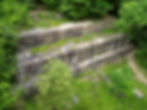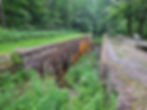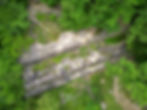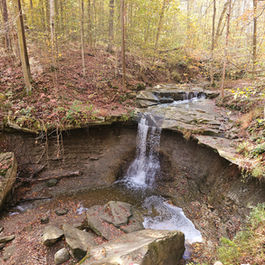Where History Meets Nature: Hiking Deep Lock Quarry
- Dan Wagner
- Jun 17, 2025
- 4 min read
Updated: Jun 19, 2025
Tucked away in Peninsula, Ohio, Deep Lock Quarry Metro Park offers more than a quiet, shaded hike through the woods. It’s a journey into the layers of time—where geology, industry, and nature intersect in a single, 73-acre preserve. Part of the Summit Metro Parks system and nestled within the boundaries of Cuyahoga Valley National Park, Deep Lock Quarry is both a recreational gem and a living museum. The heart of the park is the Quarry Trail, a 1.4-mile loop that winds through forested slopes and the ruins of long-abandoned industrial structures. At just under an hour’s walk, it’s a manageable hike for families and casual adventurers—but its true richness lies in what you’ll discover along the way.


Trailhead elevation 770'
Water none
Don't miss Lock 28
History of Deep Lock Quarry
The park's trail gets its name from the old Berea sandstone quarry that once operated here. Beginning in the 1830s, workers carved thick blocks of stone used in the construction of the Ohio & Erie Canal, including nearby Lock 28—the “Deep Lock”—which, at 17 feet, was the deepest lock on the entire canal system. Today, the lock remains intact, an imposing stone chamber reclaimed by moss and ferns, and easily visible from the trail.

In the late 19th century, a new chapter in Deep Lock’s story began. The land was purchased by Akron's own Ferdinand Schumacher, an entrepreneurial miller known as the “Oatmeal King.” Schumacher used the quarry’s sandstone to carve millstones for grinding oats at his American Cereal Works, the forerunner of Quaker Oats. These millstones helped feed Union troops during the Civil War and played a pivotal role in making Akron the oatmeal capital of America.
By the early 20th century, quarry operations began to fade. In the 1930s, the Civilian Conservation Corps (CCC) stepped in, harvesting the last usable stone to build enduring park structures across Summit County, such as the nearby Pioneer Shelter. They left behind remnants—narrow-gauge rail tracks, stone derricks, and “Dinky,” a small locomotive used to haul stone—all still visible to the curious hiker.
Since the quarry closed, nature has gently reclaimed the site. Today, it’s a peaceful haven for wildlife and wildflowers. The porous Berea sandstone continues to hold rainwater, forming small seeps and swamps that support frogs, turtles, salamanders, and a surprising diversity of birds—including rare warblers and barred owls. The shady woods are also home to a healthy population of Ohio buckeye trees, the state’s namesake species.
Deep Lock Quarry opened to the public in 1964, following decades of land acquisition by Summit Metro Parks. Today, it remains a favorite for hikers, photographers, and history buffs. The trailhead connects easily to the Ohio & Erie Canal Towpath and the Buckeye Trail, making it a perfect launching point for a longer adventure through the valley.
Hiking Deep Lock Quarry
After wrapping up hiking the Deer Lick Cave Loop in Brecksville Reservation, I make the quick drive to Deep Lock Quarry Metro Park and arrive with just under an hour of daylight left.

It's my first visit, and as I pull into the large lot, I'm surprised to find it empty. The air is quiet, heavy with that end-of-day stillness. I pass empty picnic tables and soot-stained grills, make my way past the restrooms, and reach the trailhead tucked beside a faded trail map kiosk.

The trail to the quarry begins as a broad ribbon of asphalt, gently descending into a cathedral of hardwoods. In no more than a few hundred yards, the trail levels off at a fork: to the left, a dirt path curls into the thick of the forest; to the right, the trail points toward Lock 28.

With daylight slipping fast, I choose to veer right and visit Lock 28 before moving on to the quarry. The paved trail runs parallel to the tracks of the Cuyahoga Valley Scenic Railroad, and after a short walk—maybe a hundred yards—I reach the stone walls of the lock. Like many canal locks, Lock 28 lies directly alongside the historic Ohio & Erie Canal Towpath, but its scale is immediately striking—deeper, darker, and more imposing than others I've seen. I pause beside an interpretive placard that slightly leans in the gravel, quietly telling the story of how, back in the 1820s, engineers struggled to tame the landscape here. It's those very challenges that earned this place its name: Deep Lock.

After spending a few moments at the lock, I retrace my steps to the fork and continue along the Quarry Trail. Expecting a peaceful but uneventful stroll through the woods, I’m quickly proven wrong. What unfolds is a fascinating walk through time. Every few hundred feet along the right side of the trail, pieces of the past emerge from the undergrowth—ghosts of the quarry's industrious heyday, each accompanied by a small placard offering insight into what once stood here. The first relics I encounter are a pair of enormous millstones, once used to hull oats for Ferdinand Schumacher’s German Mills American Oatmeal Company.

Not far beyond, partially swallowed by time and moss, I find the weathered remains of a loading dock over two centuries old. This was where finished sandstone blocks from the quarry were hoisted up and loaded onto canal boats, destined for cities and rail lines far beyond this quiet forest.

Further along, more giant millstones rest among the trees, their surfaces pitted and worn, like fossilized wheels abandoned mid-turn.

Then, tucked in a clearing just off the trail, I come across the stone base of an old wooden derrick. Once, this foundation supported a rig of pulleys and ropes powered by horses, used to lift immense slabs of sandstone into waiting canal boats and train cars. Now, it sits in silence—one last monument to the muscle and machinery that once carved greatness from these woods.

Just a short walk later, I reach the quarry with less than twenty minutes of daylight left. It's a striking sight. I settle onto a bench in front of it, letting the scene wash over me for a short bit.

After a moment of stillness, I climb onto the stone blocks and launch my drone, curious to see the quarry from a few different angles.

The trail continues on, and soon I'm standing at the rim, looking down at the same scene from a different angle. Nothing dramatic—just one final glimpse before I make my way back to the trailhead. It’s my first visit to the quarry, and it leaves an impression. I'm happy to have finally explored this long-overlooked corner of the valley, a place shaped by over two centuries of history.
_edited.png)





































